Abstract
This paper investigates the level of environmental degradation in the various waters surrounding the Lithgow area. It attempts to explain the origin of the degradation, its possible effects on the surrounding wildlife and why the problem still continues. The recommendation of this paper is for alternative power sources such as nuclear power be utilized in order to be independent from coal burning power plants.
Introduction
The city of Lithgow, located roughly 150 kilometers west of Sydney, would seem like one of Australia’s more idyllic locations to live due to its rich local history, ideal tourist spots and a far slower lifestyle as compared to Sydney’s hustle and bustle, appearances though can be deceiving.
An examination of the local area reveals 2 distinct problems which interconnect with each other: the presence of a massive coal mining operation located near Lithgow and the coal powered power plants that feed off the production of the local mines. Current statistics examining the revenue generated by this particular industry within the local area places it at an estimated $13 billion a year.
What must be understood regarding coal mining operations is the fact that they are notorious for non-compliance to environmental pollution regulations with 833 incidents recorded in the Springvale Colliery alone. On the very top of these violations is the spill off from water used in coal mining operation often being allowed to run back into local water systems.
The inherent problem with this is the fact that not only does this runoff contain coal particulates it also contains several other elements such as chemicals used in the mining process, base metals as well as an assortment of dust and minerals that are byproducts of mining (Mishra, Upadhyaya, Pandey & Tripathi, 2008, pp. 930 – 933).
It is based on this that the area of Lithgow warrants further investigation as to the extent of the environmental degradation happening within the local area.
Finding the Cause of the Problem
Examining Environmental Degradation Levels at Sample Sites
In order to examine the extent of the environmental degradation problem within Lithgow the several sites were examined for their conductivity, temperature, turbidity, saturated 02 levels and dissolved 02 levels in order to see the effect of the local power plants and mining operations on the local environment.
What must first be understood is the fact that conductivity is the measure by which water is able to pass an electrical current. While it may be true that water in of itself is able to pass electricity rather easily the fact remains that its overall ability to do so increases based on the amount and type of inorganic dissolved solids (particulates) that have been mixed in (Efforts to Gauge Mountaintop Mining Impacts Improving, 2011: 30).
These particulates can come in form of iron, copper, magnesium, sodium, sulfates, nitrates and a variety of other inorganic materials that can be found dissolved in water as a direct result of industrial processes or a leaky sewage system (Efforts to Gauge Mountaintop Mining Impacts Improving, 2011: 30).
The greater the amount of discharges into a stream from such processes the greater the likelihood of the water having a higher degree of conductivity. It must also be noted that conductivity is measured using mho or Siemens with most streams in Australia having measurements ranging from 50 to 1500 µmhos/cm based on local geographic features that either promote or reduce conductivity.
Another factor to consider is that in general a conductivity range of 150 to 500 µhos/cm has been determined by numerous scientific studies as being the ideal range for supporting fresh water aquatic life, levels of conductivity that are outside this particular range make the water generally inhospitable for aquatic life as the conductivity increases and leads to environmental degradation as a direct result.
The following is a table of the collected results for this study which highlight the conductivity in the areas examined.
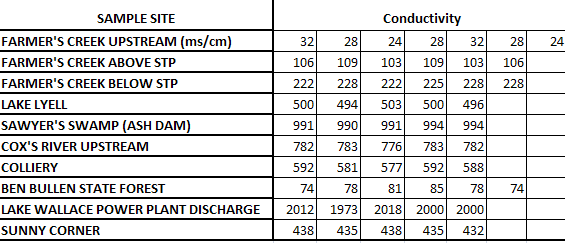
Based on the data presented it can be seen that in the upstream area of Farmer’s creek the conductivity level is on average 28 µhos/cm which is indicative of a relatively healthy water source. Interestingly though in other areas below stream the conductivity increases greatly from an its previous rating of 28 µhos/cm to well over 103 and 222 µhos/cm respectively.
This is indicative of a great deal of particulates being introduced into the water from some nearby source. While it may be true that it is still within the appropriate range for sustaining aquatic life the jump from 28 µhos/cm to 222 µhos/cm is definitely worrisome since it is indicative of introduced substances which may lead to environmental degradation.
In exploring other areas it is noticeable that water conductivity within the region is quite high with Lake Lyell having an average range of 500 µhos/cm, the Colliery showing 577 µhos/cm and Sunny corner at 438 µhos/cm. Such results, while high, can still support aquatic life yet their sheer levels is indicative of a high degree of particulates being introduced into the water which may be incredibly poisonous for local marine life.
The most worrisome areas within the places examined are Sawyers swamp (990 µhos/cm), the upstream Cox’s river (776µhos/cm), and the discharge from the power plant at Lake Wallace which gave a frightening reading of 2000 µhos/cm on average.
These readings are indicative of waters containing high levels of base metals and chemicals dissolved into them and are highly toxic to aquatic life. From the readings of conductivity alone it can be seen that the sheer scale of environmental degradation in such areas is worrisome due to not only their effect on local aquatic life but on the various communities that use such waters.
An examination of the PH level in the waters in the sample sites also presented the following results:
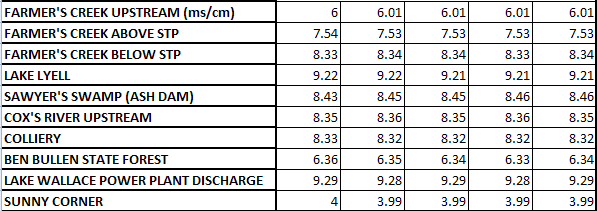
What must first be understood is that a PH rate of one to six is indicative of the water being acidic with a rating of six indicating low acidity (Lupankwa, Love, Mapani, & Mseka, 2004: 15 – 16). A rating of seven of is considered neutral while 8 and above is considered a base (Lupankwa, Love, Mapani, & Mseka, 2004: 15 – 16).
From the results it can be seen that the data from Farmer’s creek shows an increase in PH level from acidic to base, this indicative of the introduction of base particles such as metal particulates into the water. In fact as it can be seen in most of the results aside from the Ben Bullen state forest and Sunny Corner all of the results show PH levels indicative of bases present in the water.
This means that the waters in those particular locations contain high levels of metal particulates which is further backed up by the readings taken based on their level of conductivity.
The following is an examination of the Turbidity level within the areas utilized in this study:
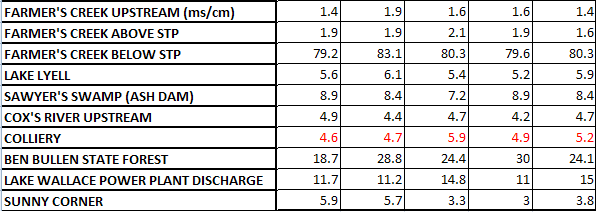
What must first be understood is that turbidity is a way in measuring the degree by which water loses its transparency with maximum allowed turbidity of safe drinking water placed at 5NTu (Rahman, Jasim, Yanful, Ndiongue & Borikar, D 2010: 295 – 301).
It must also be noted that turbidity is caused by numerous factors such as the amount of suspended sediments within water, industry waste runoff and the presence of large amounts of particulates within the water (Rahman, Jasim, Yanful, Ndiongue & Borikar, D 2010: 295 – 301).
Based on the presented data it can be seen that the turbidity level is quite high in all areas except Farmer’s creek upstream, Cox’s river upstream, Lae Lyell, and Sunny Corner. What must be understood is that high water turbidity results in waters becoming warmer due to the particles absorbing sunlight.
Some forms of aquatic life cannot live in warmer waters and subsequently die off (Rahman, Jasim, Yanful, Ndiongue & Borikar, D 2010: 295 – 301). This particular factor is further worsened by the fact that the suspended particles in the water scatter sunlight which prevent algae and plants from conducting photosynthesis resulting low oxygen levels within the water.
Furthermore particulates in the water can actually clog the gills of fish and kill fish eggs and insect larvae further worsening the degree of environmental degradation.
The following is an examination of the oxygen saturation level within Lithgow and how it affects the local marine life.
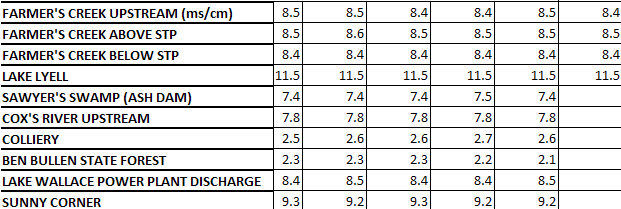
What must be understood when examining this particular examination of Lithgow’s waters is the fact that dissolved oxygen levels of 11 mg/L to 10 mg/L are considered ideal oxygen saturation levels for aquatic life.
It is only when levels reach nine to five mg/L that a slight impairment occurs in their early development with levels of 4 and below indicative of a severe problem with the oxygen content in the water which would definitely lead to increased mortality rates of aquatic life and the subsequent die off of various species within the water.
As it can be seen that with the exception of Lake Lyell and Sunny corner nearly all the locations present are not conducive towards the proper development of marine life with the Colliery and the Ben Bullen state forest having the lowest saturation levels present which would hinder the growth of various marine organisms.
This data is backed up with the following reading on dissolved oxygen with the various locations examined for this study:
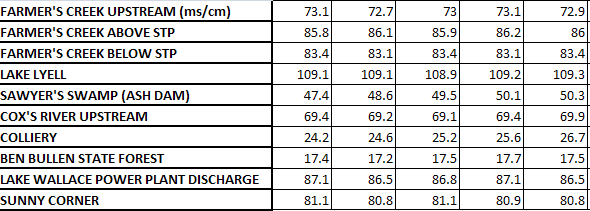
As it can be seen the dissolved oxygen examination clearly backs up the study with location such as the Colliery and the state forest showing massive reductions in oxygen saturation in the surrounding waters. What must be understood in this particular case is that is actually connected to the high levels of turbidity as well as the amount of discharge into the waters.
High turbidity rates affect the ability of aquatic plant life to produce oxygen properly since turbidity levels affect the amount of sunlight that they are able to receive. Furthermore expelled metal particulates within water supplies have been shown to drastically affect oxygen levels within bodies of water and as such the data given is indicative of massive environmental degradation for the local aquatic plant and animal life.
The following is an examination of the temperature ranges noted in the sites examined and how they affect the local environment:

When examining the temperature variances in the various locations presented what must be understood is that certain species of fish and types of algae can only survive in waters of a particular temperature. If the water gets too cold or too warm that particular species either dies off or becomes greatly reduced in number.
Based on the presented data it can be seen that the highest temperature recorded is 16 degrees Celsius while the lowest is eight. What must be understood is that certain aquatic fish species within Australia can only live in temperature variances of 15°C to 23°C. Any lower than that and the water becomes too cold for them.
As it can be seen in the presented data aside from locations such as the Lake Wallace power plant and Farmer’s creek all the other areas have very low temperatures. While it may be true that water with lower temperatures are able to hold more oxygen as indicated by the previous table regarding oxygen saturation the fact remains that fish or certain types of plant life cannot live in water that is too cold.
This particular problem can actually be traced to problems regarding water turbidity and the sheer murkiness of the water prevents sufficient sunlight from enter certain parts of the waters resulting in a subsequent cool down of the water temperature.
The following is an examination of the phosphate and nitrate concentrations within the sampled areas:

When comparing the phosphate and nitrate levels examine from the upstream area of farmer’s creek to the downstream area the levels went up significantly for both phosphates and nitrates.
This is indicative of some form of pollutant being introduced between those two locations and as such is indicative of a problematic form of environmental poisoning since high doses of phosphates and nitrates is deadly to certain plant and fish species.
Reasons behind the Ineffectiveness of the Current Method of Remediation
Current estimates of the electrical use per household within Sydney shows that on average a home/apartment in Sydney spends roughly $1,500 per year on electricity consumption with an average daily use of 17 to 31 kWhs (Kilowatt-hours) per day or 8250 kWh per annum (Australia: Market profile, 2004: 22 – 23).
This results in the production of 8 tones of carbon pollution per household created each year due to the fact that 90% of Australia’s energy needs are met through the use of fossil fuel burning power plants (Australia, 2005: 39 – 44). With a population density of 4,575,532 this represents literally billions of tones of carbon pollution released into the atmosphere on a yearly basis.
One factor to consider when taking such figures into consideration is the fact that Sydney’s population is estimated to grow to at least 6 million by 2035 resulting in an even greater strain on the city’s resource infrastructure (Australia, 2005: 39 – 44).
This means that the use of utilities such as electricity will continue to grow along with the amount of carbon pollution released into the atmosphere which will reach astronomical rates due to the increase in domestic consumption.
The reason these particular facts are mentioned is due to the fact that they are directly responsible for the current problems in remedying the problem regarding environmental degradation in Lithgow.
First and foremost is must be mentioned once more that 90% of Sydney’s current power supply comes direct fossil fuel resources of which coal burning power plants contribute a great percentage to (Hindmarsh & Matthews, 2008: 217 – 228).
As the population of Sydney grows and the demand for power increases it has been shown by studies such as those by Hindmarsh and Matthews (2008) that the predilection of the Australian government has been to create more fossil fuel burning power plants due to their relatively inexpensive cost in building and the fact that they have worked effectively for so long (Hindmarsh & Matthews, 2008: 217 – 228).
In fact there are already even more plans to build several more fossil fuel burning power plants near the Lithgow area due to its proximity to coal deposits that fuel most of these plants.
While it may be true that governments have the responsibility in ensuring the continued safety and health of their populace the fact remains that in case of the ever increasing power demands of Sydney it is apparent that the needs of the many outweigh the needs of the few and in this case the apparent effect of mining and building power plants within the local area takes precedence over the health and well-being of citizens within Lithgow.
How else can it be explained that despite the flagrant environmental abuses by both the mining and power plant companies that their activities have continued to remain in operation.
It has already been shown by numerous studies investigating the area that the local environment has been affected and that people within Lithgow are obviously getting sicker and sicker as a direct result of these actions yet few direct actions have been done.
The fact is that the government can ill-afford any interruptions to Sydney’s voracious appetite for power, stopping operations at power plants and mines that have exhibited flagrant abuses of the environmental code would cause a potential power crises within Sydney affect the cities economy which would definitely be detrimental for government.
It is based on this that despite numerous means of remediation or intervention it is unlikely that any venture will truly succeed unless alternative forms of power can be found immediately to replace fossil fuel usage, an outcome that is highly unlikely within the immediate future.
Possible Strategies that can be utilized to address the Problem
Direct Government Intervention
One of the current problems in the environmental degradation in Lithgow is the fact that there is a distinct lack of direct government intervention in addressing or even properly acknowledging the fact that there is even a problem at all.
For example, the government, while generally supportive of environmental preservation and conservatism, has failed to take into account the potentially hazardous situation involving the city’s water supply and how it continues to be tainted by both mining activity and the generation of electricity by the local power plants.
If greater government intervention could occur in this situation involving either stricter penalties or the threat of possible closure of either a power plant or a mine for failing to live up to proper environmental standards of operation then this would go a long way towards resolving the current environmental degradation within the local area (Franz, 2011: 27 – 35).
Direct government intervention in this case would involve stricter tests, an acknowledgement of the seriousness of the situation in Lithgow and lawfully enforceable mandates that if ignored or otherwise not followed would result in an immediate closure of the business with possible criminal charges brought against the owners (Franz, 2011: 27 – 35).
It must be noted though that despite this particular method possibly bringing about the greatest potential remedy for the current problem it is unlikely to occur due to several reasons. The first involves the situation mentioned earlier regarding the power hungry nature of Sydney and its continually increasing energy requirements.
The second is the fact that jobs mining and working for the electrical companies are actually one of the backbone careers within the local community and their loss would result in a devastating blow for possibly hundreds of people.
The final reason is the fact that evidence showing otherwise (i.e. Lithgow having one of the highest rates of cancer, heart attacks and asthma in the world) has not been properly connected to the activities of the electrical and mining industry where there have been too few studies which have properly investigated the problems in the area and verifiably connected them to the current state of people within the Lithgow local community.
Without valid research and public support behind it, there is very little likelihood that the government will even attempt to do anything at all.
It is based on this that while this particular option would result in the greatest amount of direct change it is also an approach that would least likely happen due to the nature of governments being swayed by the beneficial affects of a project in its entirety rather than the detrimental effects it could have on a minority (Dvořáček & Slivka, 2008: 20 – 23).
Recommended Solution
The inherent problem with finding a solution to this issue is the fact that the problem goes far beyond just environmental degradation caused by the activities of local companies but rather is connected to the power needs of Sydney. It can actually be expected based on the estimates given within this paper that as Sydney continues to grow so to will its power needs which as a result will directly affect Lithgow.
There are already potential plans being formulated to build even more power plants within the area resulting in even more environmental degradation in the coming years. The only feasible way it can be expected that there will be a resolution to this issue is that the power needs of Sydney can be met in an alternative way that doesn’t rely on coal fired power plants.
One of the potential avenues of approach that has been advocated by local environmental groups is the use of renewable energy resources as an alternative to coal fired power plants. The main issue with renewable energy resources is that they are as of yet an unreliable form of main energy generation for a country.
Commercially speaking when comparing fossil fuel burning power plants to either solar powered arrays or wind turbines, most energy producers would choose to construct a fossil fuel burning plant rather than a renewable energy production site. The reasoning behind this is simple, fossil fuel power plants simply require less space and produce more power compared to solar or wind generated energy sources (Brownless, 2008: 525).
This is actually one of the primary reasons why 90% of Sydney’s power supply is from fossil fuel powered power plants they are simply cheaper, produce what is needed and easy to setup as compared to renewable energy production.
It is based on this that a shift toward the production of electricity through nuclear fuel presents itself as a viable method of resolving the current problem of environmental degradation within the Lithgow area. Nuclear power plants (NPP) would be a viable option to consider as a means of expanding the current energy producing capabilities of Sydney.
Not only can NPP’s produce the amount of electricity needed they can do so at a fraction of the cost associated with fossil fuel burning plants (Brownless, 2008: 525). On average, a single fossil fuel power plant can go through several hundreds of pounds of coal in a single day, NPPs on the other hand use nuclear fuel rods which can last several years and are relatively inexpensive when compared to costs of tons of coal.
While there are concerns regarding the possibility of meltdowns and radiation poisoning, most NPPs have several backup systems to prevent this and so far in the history of the technology only 3 incidences of a nuclear meltdown have occurred and in all cases it was usually due to human error and not a failure of the technology itself (DEBATE, 2010: 22).
Daily operations at an NPP are not as polluting compared to the emissions of fossil fuel burning power plants (DEBATE, 2010: 22). The steam seen being emitted by various NPPs is merely evaporated water and does not truly present a threat to the environment. As such as far as emissions are concerned nuclear technology is a far cleaner method of energy production (Motavalli, 2007: 26).
As for its ability to produce electricity, a single nuclear reactor (depending on the size and scale) can rival and exceed the energy producing capabilities of several fossil fuel power plants and the amount of energy loss is also minimized due to the overall design of the energy collection system.
Measuring Improved Management
There are two distinct measures by which improved management can be determined: improved water conditions and fewer health related concerns within Lithgow. Improved water conditions come in the form of lower conductivity levels, better water turbidity and a neutral PH level in the water (McKee, 1972: 88 – 91).
By achieving such results this will enable a far more stable aquatic environment that would encourage environmental recovery rather then environmental degradation. Secondly it has been shown by studies that the population of Lithgow has a 20% higher cancer rate as compared to any other area within New South Wales.
This is quite obviously a result of the consumption of tainted water and as such a measure of improved management within the local area is a lowering of the cancer rate to normal national levels (Something in the water, 2011: 146).
Conclusion and Recommendation
Based on the findings of this paper it can be seen that the level of environmental degradation within the various sites investigated within the Lithgow area is a direct result of the activities of the power plants and mining sites within the local area.
Despite the source being obvious an effective resolution is not quite possible due to their connection to the power necessities of Sydney. It is based on this that it is recommended that alternative power sources such as nuclear power be utilized as an alternative means of generating power for Sydney within the foreseeable future.
Reference List
Australia. (2005). Energy Forecast World, 39-44.
Australia: Market profile. (2004). Energy Forecast Asia & Australasia, 22-26.
Brownless, G. P. (2008). Does protecting humans protect the environment? A crude examination for UK nuclear power plants and the marine environment using information in the public domain. Journal of Radiological Protection, 28(4), 525- 538.
DEBATE. (2010). New York Times Upfront, 143(2), p. 22.
Dvořáček, J., & Slivka, V. (2008). Interventions of state in favor of mining industry in EU countries. Minerals & Energy, 23(1), 20-28.
Efforts to Gauge Mountaintop Mining Impacts Improving. (2011). BNA’s Environmental Compliance Bulletin, 18(2), p. 30.
Franz, A. (2011). Crimes against water: non-enforcement of state water pollution laws. Crime, Law & Social Change, 56(1), 27-51.
Hindmarsh, R., & Matthews, C. (2008). Deliberative speak at the turbine face: Community engagement, wind farms, and renewable energy transitions, in Australia. Journal of Environmental Policy & Planning, 10(3), 217-232.
Lupankwa, K., Love, D., Mapani, B., & Mseka, S. (2004). Impact of a base metal slimes dam on water systems, Madziwa Mine, Zimbabwe. Physics & Chemistry of the Earth – Parts A/B/C, 29, 15-18, 1145-115.
McKee, J. (1972). Water pollution control: A task for technology. California Management Review, 14(3), 88-91.
Mishra, V., Upadhyaya, A., Pandey, S., & Tripathi, B. (2008). Heavy metal pollution induced due to coal mining effluent on surrounding aquatic ecosystem and its management through naturally occurring aquatic macrophytes. Bioresource Technology, 99(5), 930-936.
Motavalli, J. (2007). A nuclear Phoenix? E: The Environmental Magazine, 18(4), p. 26.
Rahman, M., Jasim, S., Yanful, E., Ndiongue, S., & Borikar, D. (2010). Advanced oxidation treatment of drinking water: Part II. Turbidity, particles and organics removal from lake Huron water. Ozone: Science & Engineering, 32(5), 295-304.
Something in the Water. (2011). Parents (10836373), 86(4), p. 146.
Taylor, J., & Van Doren, P. (2009). Market power. National Review, 61(20), p. 52.